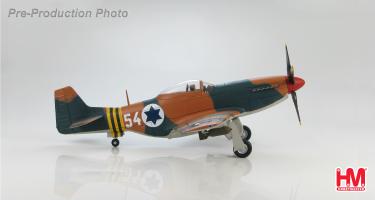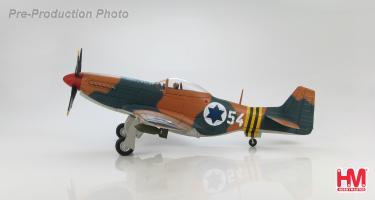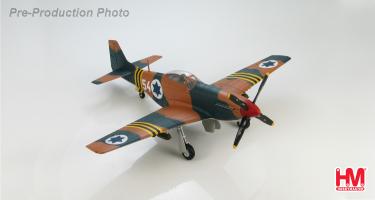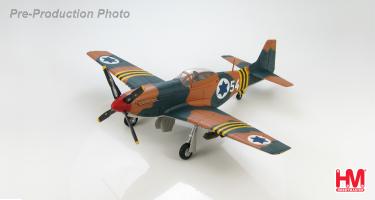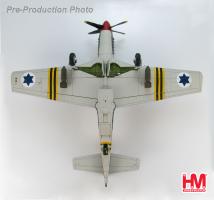Hobby Master Archive
Air Power Propellers 1/48
P-51D
P-51D Mustang 105th Squadron Scorpion Israeli Air Force, Suez Campaign 1956
Later in WWII the Allied bombers were flying deep into Germany but suffered tremendous losses because of the lack of range the fighter escorts had. German fighters would wait beyond the range of the Allied fighters and then attack the vulnerable bombers. Once the P- 51 called Mustang by the British had the Allison engine replaced with a British Merlin it possessed the high performance that had been lacking. With drop tanks the P-51 had the range to escort bombers all the way to Berlin and back.
“Operation Musketeer” is perhaps better known in the West as “The Suez Crisis of 1956.” It is also known in Israel as “The Sinai War.” August 20th 1950 saw the creation of an operational training body within the “First Fighter” Squadron. Within a few months the unit had expanded and became a separate squadron. It began to operate their Spitfires from the Ramat David Air Base as the 105 Squadron “Barak” (Scorpion). In the summer of 1956 the squadron traded their Spitfires for approximately 20 P-51D Mustangs. Because of blockades of the Suez Canal and the Sea of Aqaba as well as repeated Fedayeen attacks and the statements being made by some Arab countries Israel felt it necessary to carry out a pre-emptive strike against Egypt. The first mission took place on October 29, 1956 when P-51d’s from the 105th Squadron attacked Egyptian communication facilities. It was thought that if the telephone lines were destroyed this would force the Egyptians to use radios and their transmissions could be intercepted and the Israelis would know their intentions. Flying as low as 50 feet above the ground three flights of four Barak Mustangs headed out to sever the telephone lines. Approaching the target a 100 foot cable was lowered from the tail to snag the lines and break them. It is said one pilot used his propeller blades to do the job. It is reported that all but 1 aircraft returned and the loss was attributed to anti-aircraft fire. On October 31, 1956 the Mustangs entered the actual fighting. Because of their capability to fly long distances they were used on strike missions against enemy forces, outposts, fortified points, roads, shipping and other targets. The Mustangs flew 184 missions during the Suez Crisis campaign, losing 7 aircraft. With the advances in jets and anti-aircraft weapons the P-51 was retired from the Israeli Air Force on January 15th, 1961.
Specifications for the North American Aviation P-51D Mustang Tasks - Dive-bomber, bomber-escort, ground-attack, interceptor, photo recon Number Produced All Variants - 14,819 Dimensions Wing Span - 37 ft (11.27 m) Length - 32 ft 3 in (9.82 m) Height - 13 ft 8 in (4.16 m)
Weight Empty - 7,125 lb (3,232 kg) Gross - 10,100 lb (4,581 kg) Maximum Take-off - 11,600 lb (5,262 kg)
Performance Engine - Packard Merlin two-staged supercharged V-1650-7, 12 cylinder V engine 1,695 hp. Maximum Speed - 437 mph (703 km/h) Ceiling - 41,900 ft (12,771 m) Range - 950 miles (1,529 km) Maximum Range - 2,300 miles (3,701 km)
Armament 6 x .50 caliber MG Maximum External Bomb Load - 2,000 lb (907 kg) Or 4 x .5 inch rockets.
Hobby Master 1/48 Air Power Series HA7709 P-51D Mustang 105th Squadron “Scorpion” Israeli Air Force, Suez Campaign 1956
1/48 scale pre-finished Die-cast metal with a minimum of plastic. Professionally painted. All markings pad applied for superb results. Cockpit slides open. Comes with a pilot that can be removed. Comes with display stand. Can be displayed with landing gear up or down.
| Added to archive | 2015-11-19 |
| Last modified | 2015-11-19 |
| Leaflet | 2013-06-01 June 2013 |
